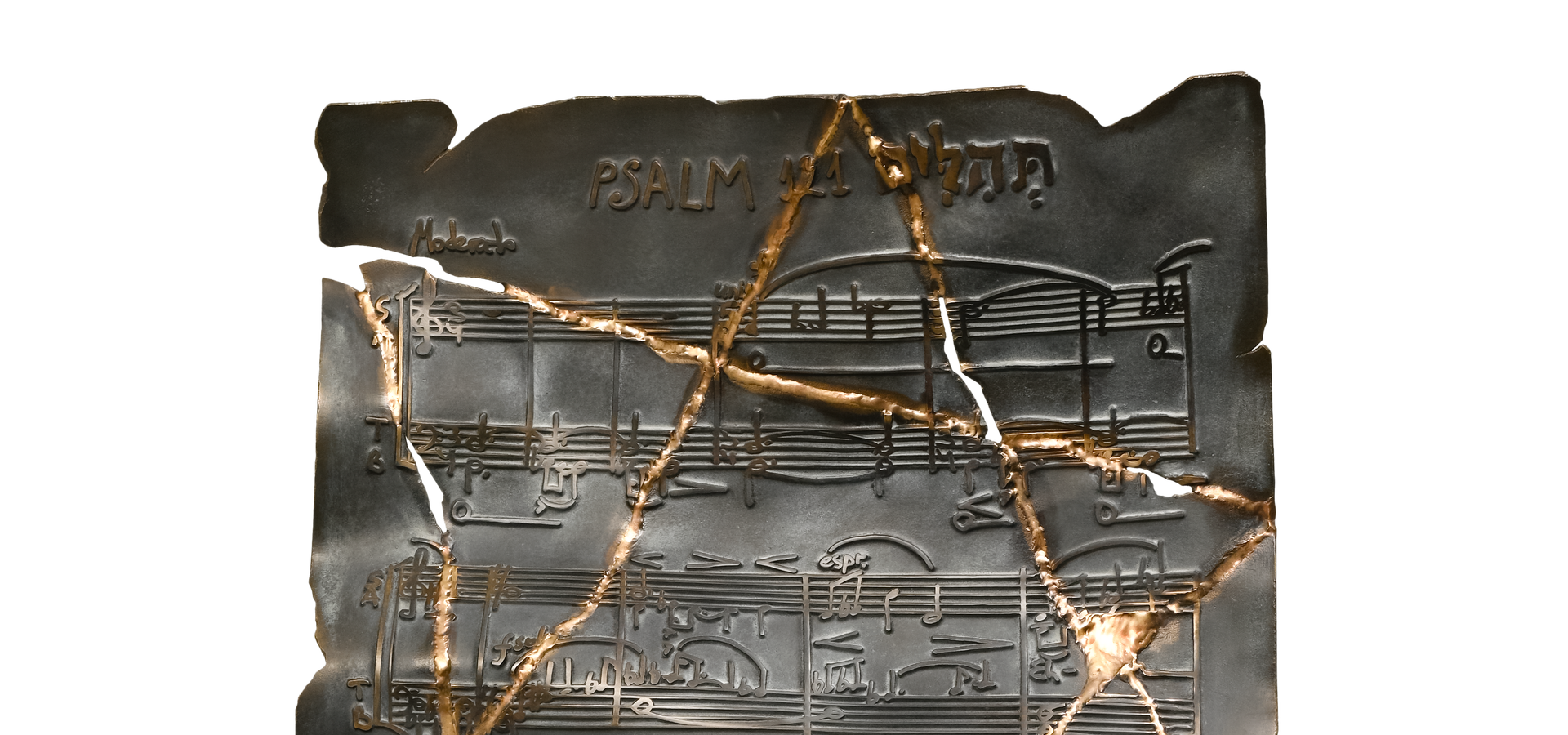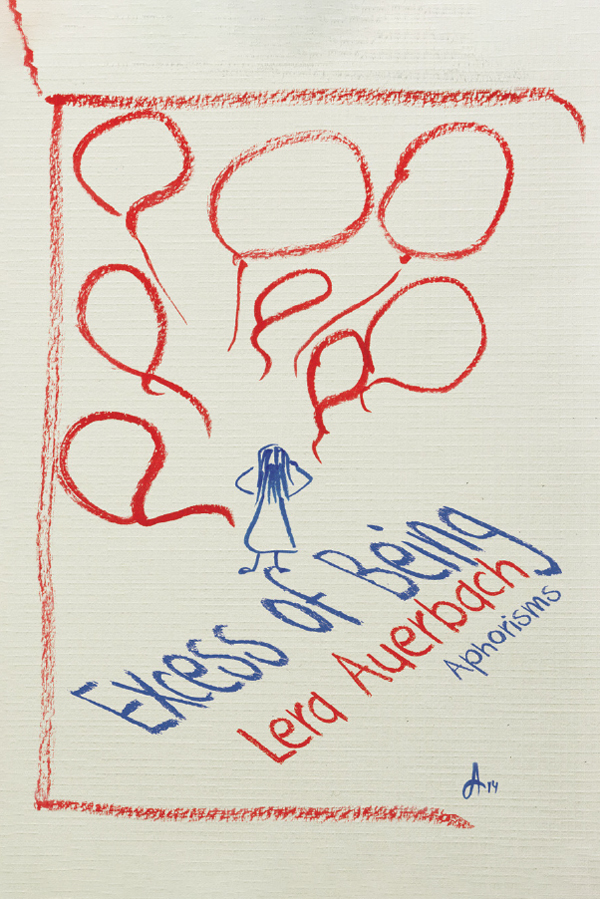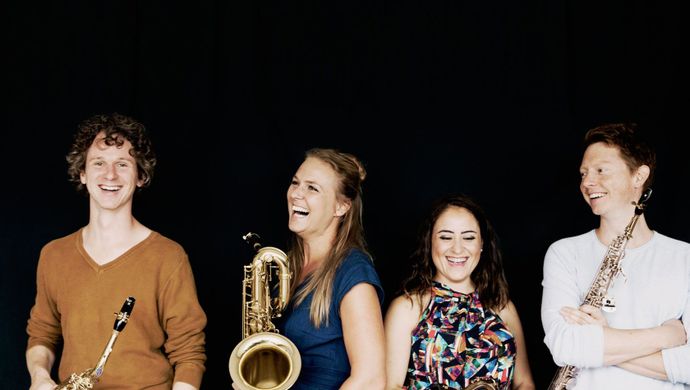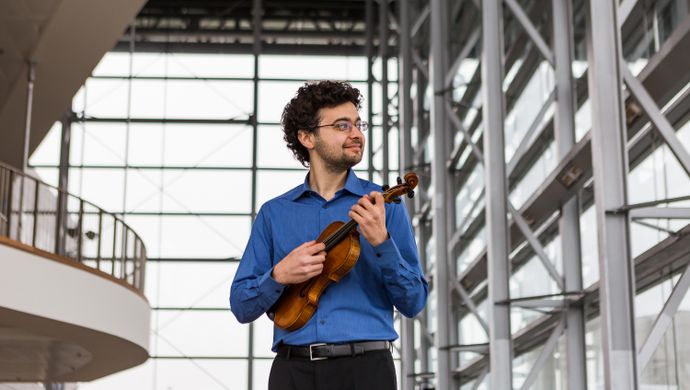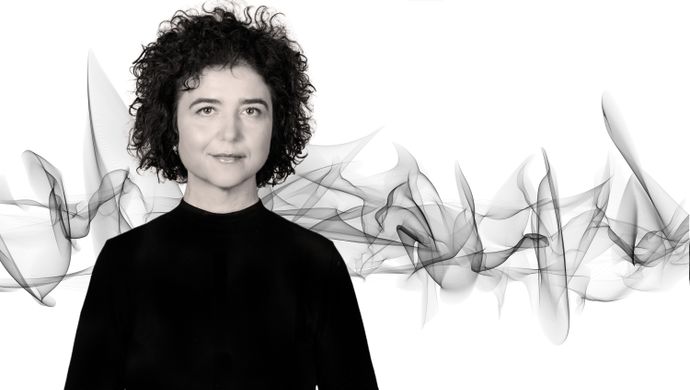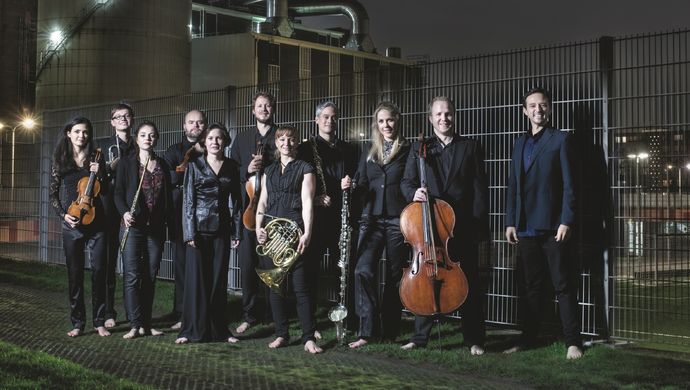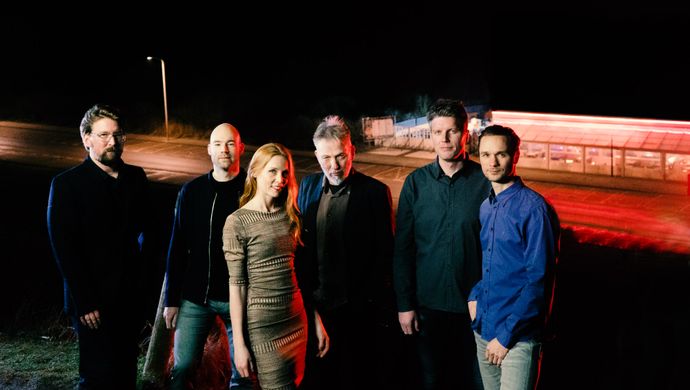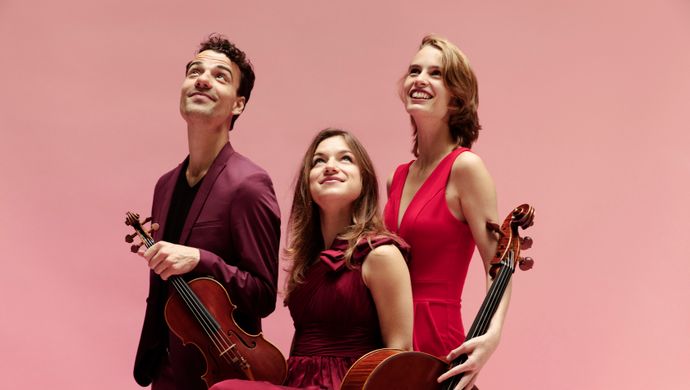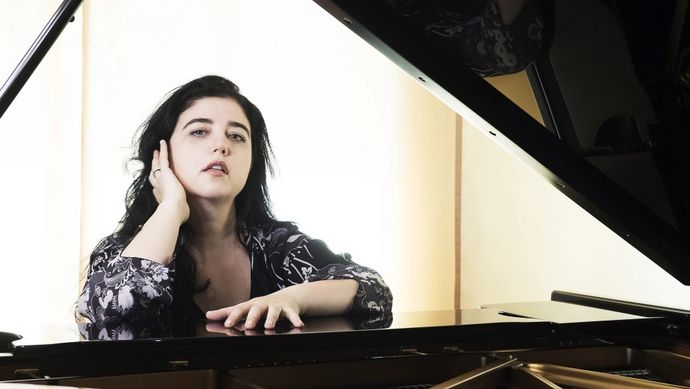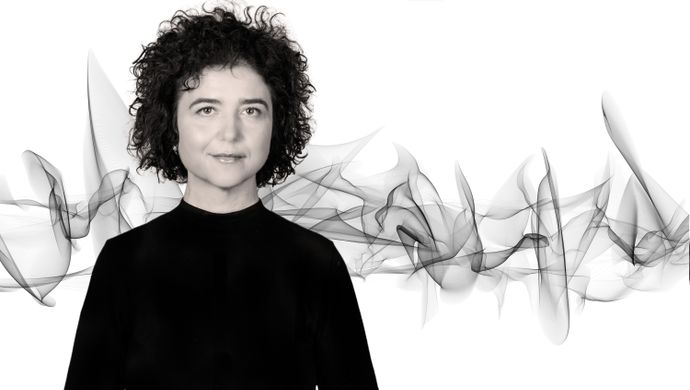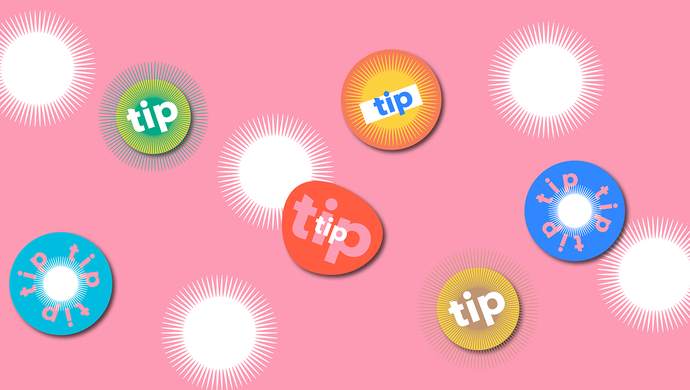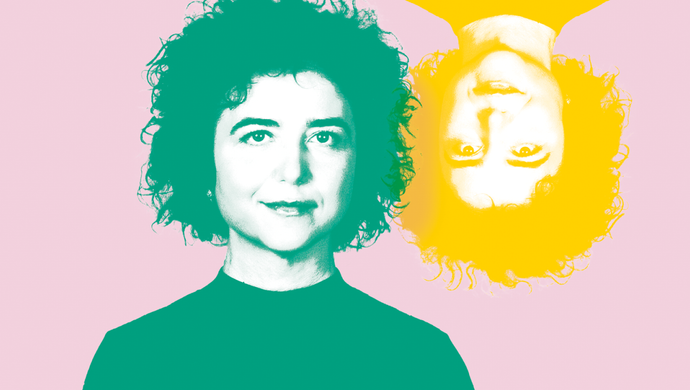Sculpturen van Lera Auerbach
Transmutations: Between Fragility and Permanence
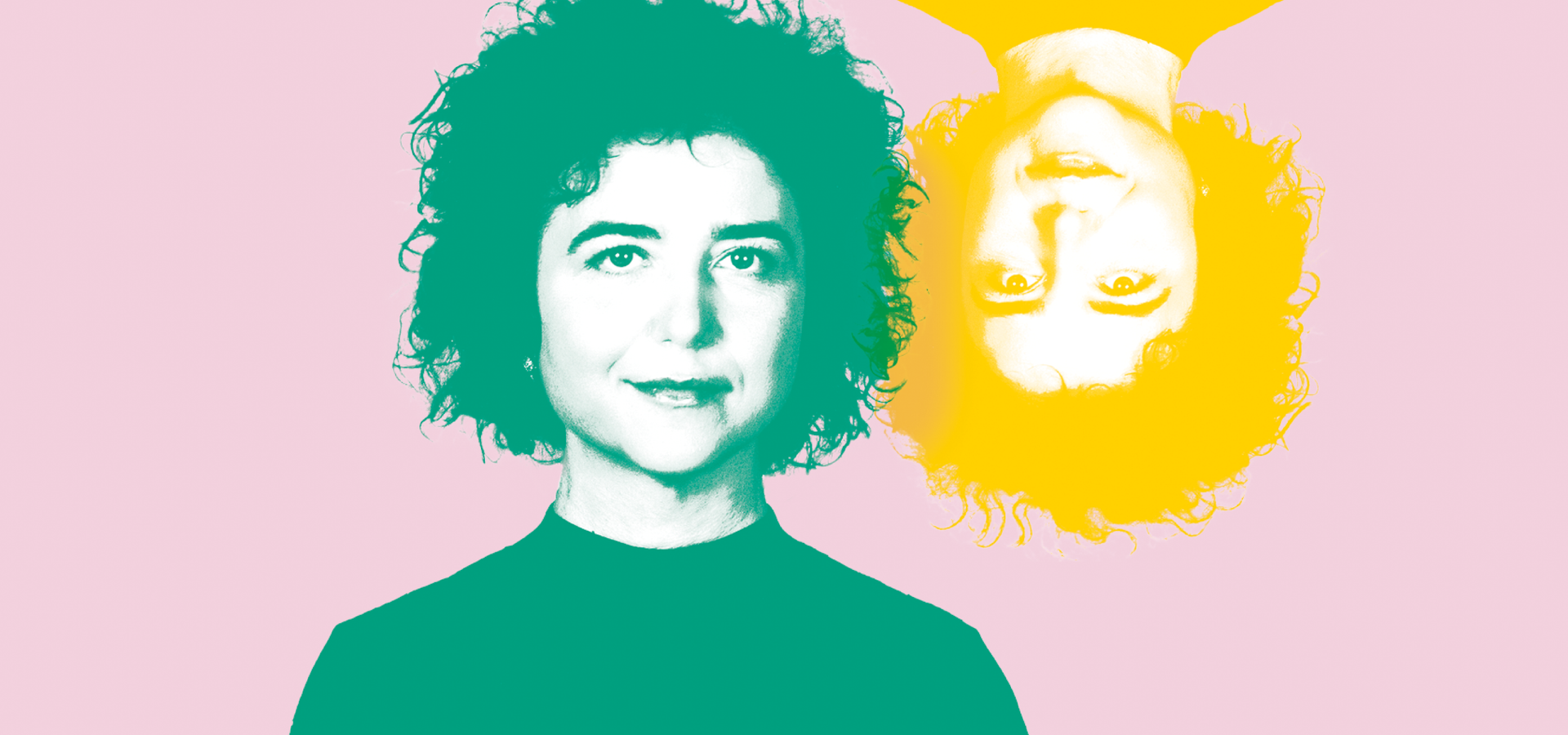
Auerbachs werken gedreven door levenservaringen
Voor het eerst worden er diverse bronzen sculpturen van Lera Auerbach uit Wenen, Berlijn, Miami en New York samengebracht voor een unieke tentoonstelling in Amare.
Sculpturen van Lera Auerbach:
Transmutaties: Tussen Kwetsbaarheid en Permanentie
Vrijdag 13 t/m zondag 22 oktober
Foyer 2, Amare
Vrije toegang
Transmutaties: Tussen Kwetsbaarheid en Permanentie
In Lera Auerbachs caleidoscopische kunstuniversum ontmoeten we een betoverende dans tussen contrasten en consonantie, waar het cerebrale en het zintuiglijke voor altijd verstrengeld zijn in een symbiotische choreografie. Het is een ruimte van ongeëvenaarde artistieke vindingrijkheid, waar intellectuele strengheid naast emotionele resonantie bestaat en de grenzen overstijgt die vaak individuele media zoals beeldhouwkunst, muziek en literatuur isoleren. Elk element van haar werk—of het nu een bronzen sculptuur of een literaire compositie is—dient als een tak in haar uitgestrekte boom van creatief leven, bijdragend aan een overkoepelend verhaal dat even veelzijdig is als het met elkaar verbonden is.
Haar sculpturen stralen uit van een intuïtieve kern die verfrissend onaangeraakt blijft door de beperkende normen van formele academische paradigma's. Auerbachs werk wordt gedreven door de som van haar levenservaringen. Een cruciaal moment was de verwoestende brand die in 2009 haar huis en studio in New York verwoestte, haar bibliotheek, muziekmanuscripten, persoonlijke bezittingen, kunstcollectie en concertvleugel vernietigend. Herrijzend uit de as vond ze in het act van beeldhouwen een cathartische uitlaatklep voor haar intense emotionele en psychologische staat. Deze artistieke pelgrimstocht dient als een getuigenis van haar veerkracht, een viering van de vernieuwing die voortkomt uit het confronteren van iemands eigen kwetsbaarheid en vergankelijkheid.
In een fascinerend spel van materiaal en thema worden haar sculpturen vaak gegoten in brons—een metaal dat kracht, permanentie en onveranderlijkheid symboliseert. Deze keuze dient als een meeslepend tegenwicht voor haar verkenning van de fragiliteit, impermanentie en vergankelijkheid van het leven. Elk stuk is een tastbare manifestatie van deze spanning, een delicaat evenwicht tussen antithetische krachten. Ze worden arena's waarin ruwe emotionele energie en conceptuele strengheid botsen, resulterend in een alchemistische transformatie die het gewone verheft tot het buitengewone.
Terwijl ze diepe duiken aanbiedt in de lagen van de menselijke psyche, functioneren haar werken tegelijkertijd als spiegels die haar eigen complexe zelf weerspiegelen. Elke sculptuur vat haar persoonlijke ervaringen samen net zo veel als het vibreert met universele resonantie, pulserend met de gedurfde vitaliteit die ons tijdperk definieert. Meer dan alleen esthetische stukken nodigen ze de waarnemer uit op een reis door de labyrintische complexiteiten van menselijke emoties, intellectuele overwegingen en sociale verhalen.
Bovendien draagt Auerbachs kunst een extra laag van betekenis die voortkomt uit haar wortels. Geboren in de buurt van de regio die is getekend door het radioactieve besmettingsongeval bij de Mayak-plutoniumproductie-installatie, bevatten haar werken een onontkoombare ecologische ondertoon. Ze zijn zowel een uitdrukking als een waarschuwing, absorberend en reflecterend de milieu-issues die integraal zijn aan de tijdgeest die ze bewoont.
Auerbachs sculpturale universum is in essentie een ingewikkeld tapijt dat diverse draden samenweeft: persoonlijke geschiedenis, emotionele intensiteit, materiële dialectiek, sociale commentaar en intellectuele diepgang. Het resultaat is een evocatief verhaal dat zich bezighoudt met een voortdurende interne dialoog, het verleden koppelend aan het heden, het persoonlijke aan het universele, en het abstracte aan het tastbare. Deze dynamische wisselwerking binnen haar oeuvre markeert Auerbach als een unieke stem in de hedendaagse kunstwereld—een stem die even meeslepend is als complex en even relevant als tijdloos.
Tekst door: Ilona Oltuski
Bekijk en beluister hieronder alle toelichtingen op de sculpturen:
Moonrider
"Moonrider" features a celestial-headed human figure riding a menacing creature reminiscent of a panther, its mouth defined by sharp shark-like teeth. Its body's texture resembles a lunar landscape with craters, adding to its mystique. This sculpture's creation was contemporaneous with Auerbach's opera "Gogol," where the moon is a character, imbuing "Moonrider" with additional layers of symbolic meaning.
In Auerbach's life, "Moonrider" has taken on a role akin to a protective gargoyle. Positioned above her bed for many years, it served as a silent guardian, reflecting the themes of protection found in her children's poem, which inspired her Symphony No. 3, "The Infant Minstrel and His Peculiar Menagerie":
– Moon Rider, Moon Rider, help me tonight!
My thoughts are scattered from troubles of heart.
Take me along on your flight through the dark –
Away from my thoughts and their howling bark!
Moon Rider answers: "Come along!
Find the silence that is your own –
It is your safety, your true voice, your home.
Do not despair: You are never alone.
In the manner of the gargoyles adorning Gothic cathedrals, "Moonrider" emerges as a ferocious guardian, a vigilant sentinel at the entrance to the subconscious. It attests to Auerbach's skill in blending visual art, literary motifs, and musical composition into a cohesive and evocative expression of creativity and imagination. It embodies the convergence of the mythical and the real, a creative quest that encourages us to probe our connection with the obscure, the mystical, and the unknown.
"Moon Rider" stands as a multifaceted symbol at the intersection of Auerbach's creative pursuits, marking itself as more than a sculpture; it's a complex narrative and a bridge between the seen and the unseen, the conscious and the subconscious.
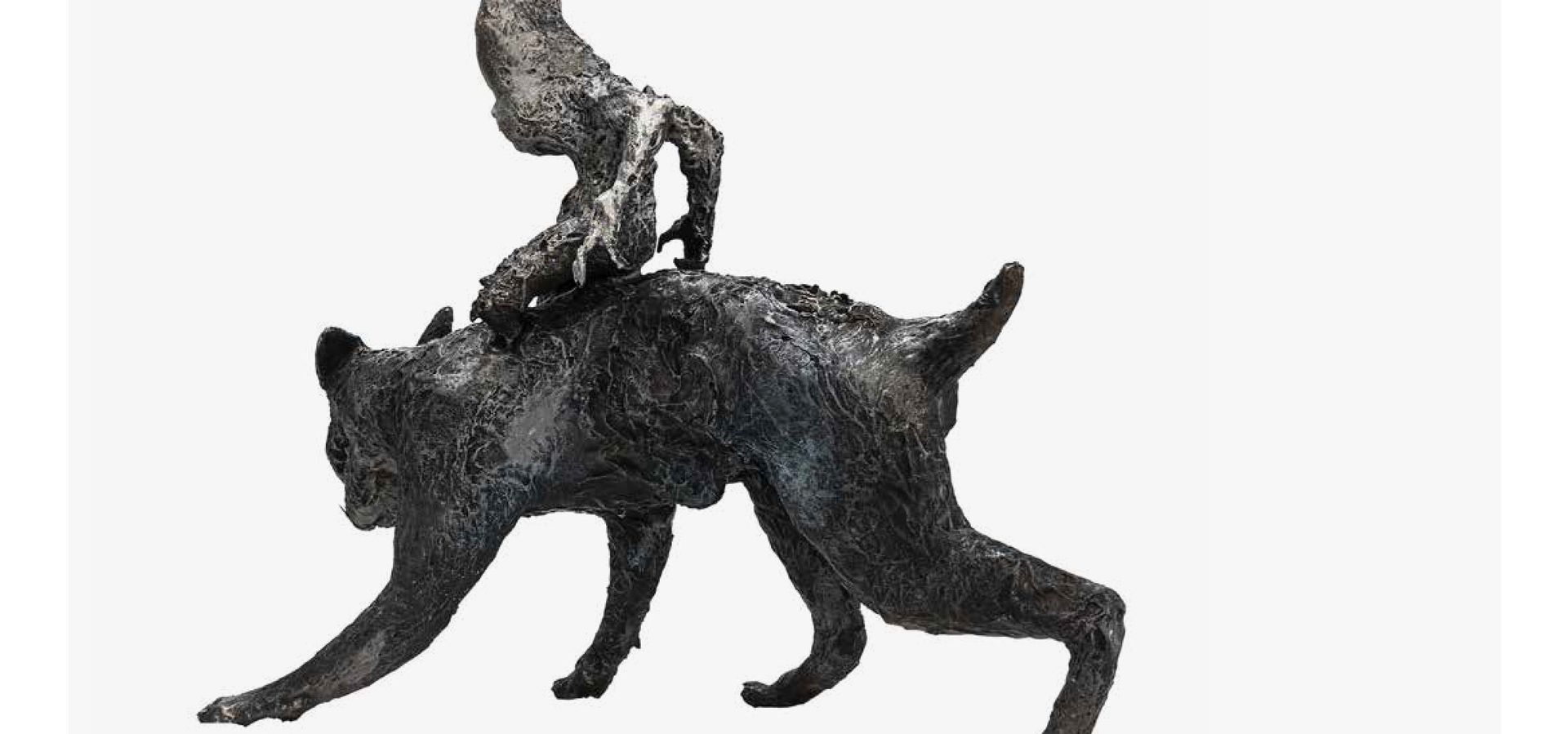
Motherhood
An unsettling vision of maternity is revealed in Auerbach's "Motherhood", a multilayered blend of form and allegory. More a disquieting manifestation of cultural constraints and expectations placed on women than an ode to natural birth, the piece resonates with social, cultural, and gender issues.
The female figure, with its doll-like features, is a stark commentary on the societal objectification of women. The face, obscured by hospital gauze, alludes to the medicalisation of childbirth, the shadowing of personal identity, and the erasure of the woman's individuality. The gauze becomes a veil, concealing and suppressing the true self, transforming the unique human being into a role defined by society. Personal identity is supplanted by the archetypal mother role, laden with cultural meanings and burdens.
The sculpture's startling feature, a hinged door on its torso, reveals a child's face patinated in gold and encircled by verdant greens, confronting viewers with the dichotomy between the natural nurture of motherhood and its commodification. Auerbach's choice to frame the child's face may be interpreted as a comment on society's fixation on the 'product' of motherhood rather than the process itself.
Adding complexity is the inclusion of oversized high-heeled shoes. Their exaggerated size speaks to the overwhelming societal roles women are often compelled to fulfil, constructing an unattainable ideal. These elements remind us that expectations surrounding femininity and motherhood frequently exceed what is reachable and authentic, mirroring inherent imbalances and struggles.
Auerbach's composition serves as both reflection and critique, capturing complex intersections of identity, gender, and societal norms. The sculpture is an impactful contribution to dialogues about women's roles, reflecting an evolution in understanding these themes.
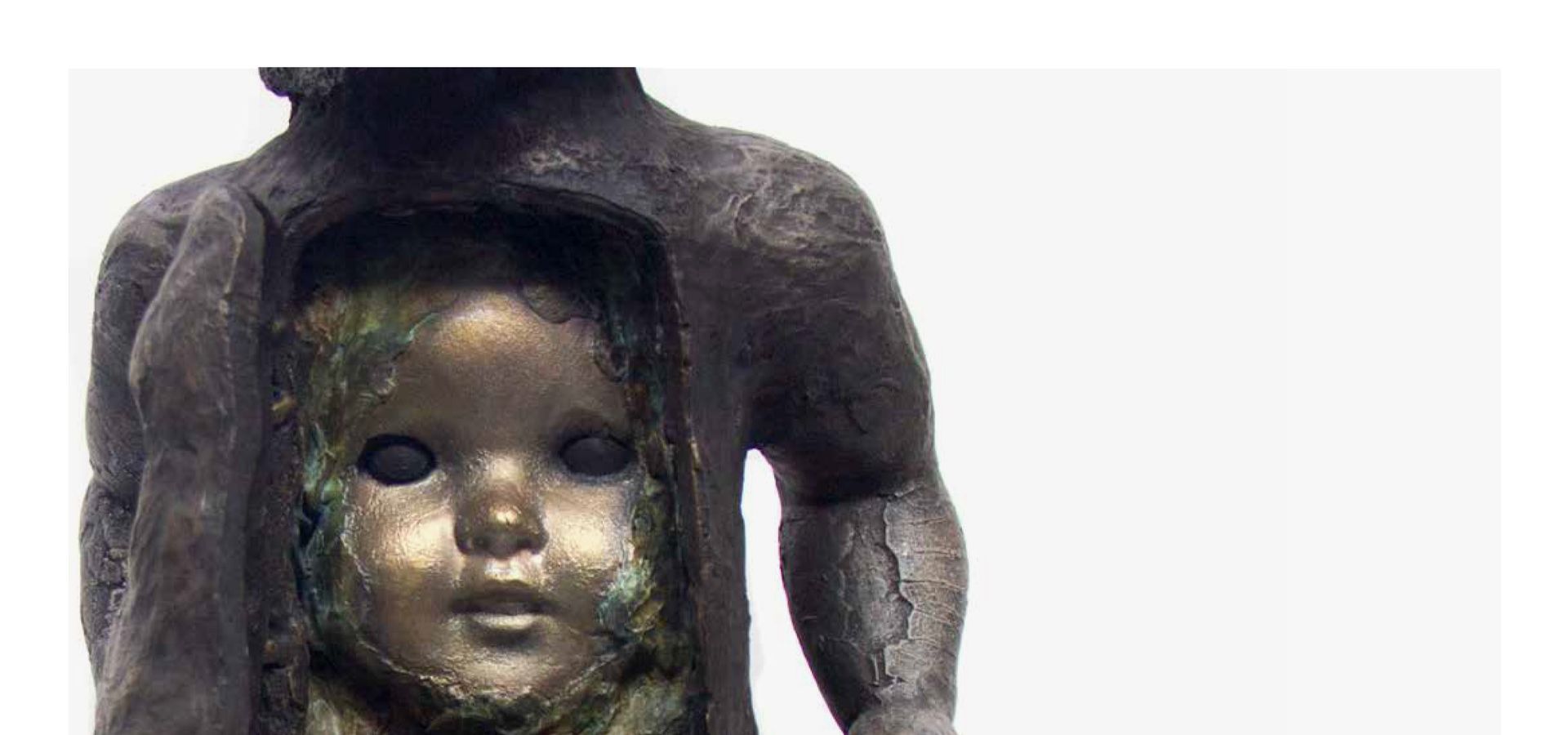
Totentanz
In "Totentanz," Lera Auerbach crafts an arresting figure, both cat-like and spectral, its form decaying yet imbued with a fiercely enigmatic grace. Caught in an eternal leap, it's as if the dancer has sprung from the flames that char the manuscript of her solo piano score "Memento Mori." This mesmerizing juxtaposition of life and death, beauty and decay, captures a moment frozen in time, echoing the ecstatic nature of existence itself, resonating with the eternal role of art while imbuing it with the vital spark of the flames.
The figure's leap moves beyond a visual spectacle, becoming a metaphor for life's fleeting yet creative essence. It is a graceful dance on oblivion's edge, illuminated by the unquenchable fire of existence. This fire lures us into a grand dance, orchestrating a harmony of movement, entropy, and music, kindled by the eternal flame and continuing to resonate long after the physical form has yielded to time's ephemeral caress. The cat-like figure, suspended between vibrance and immolation, becomes a mirror reflecting our intricate Dance with Death.
Intertwining the elemental themes of creation and destruction, the sculpture draws upon historical allegories, such as the Dance Macabre or Dance of Death, to deepen its resonance. These elements coalesce into a profound reflection on the universality of death and rebirth. Themes of creation, allure, demise, and renewal, mingled with the illusory solidity of existence, craft a synthesis that invites contemplation on eternal and immediate matters.
We are drawn into a reflection that is both universal and deeply personal. It is a dance we all partake in, a melody that lingers in the air, embraced and transformed by the creative fire long after the last note sounds.
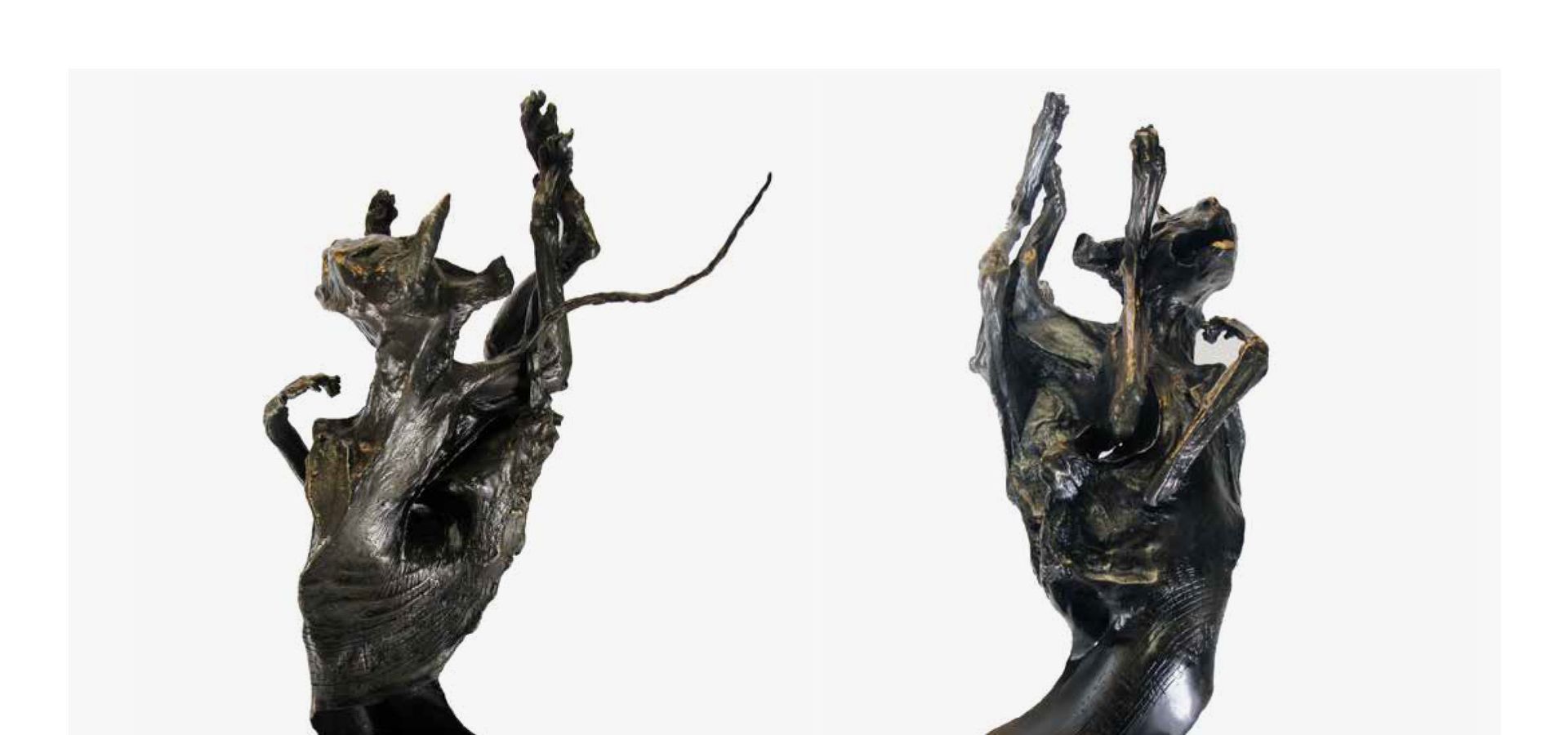
Hold me
An ambiguous, fragile creature—delicate, innocent, and embodying the ephemeral nature of life itself—is cradled within an aged hand, distinguished by time and grace. Its essence is mysterious, and its form evokes vulnerability and wonder. From the creature's perspective, the surrounding warmth creates a nurturing bond, akin to a parent holding a newborn or humanity's connection to nature. This momentary union is safe yet bewildering, a delicate balance in an uncertain world.
Simultaneously, the creature arouses fear of the unknown and the intangible—an unsettling sensation fueled by the terror of losing touch with the essence we strive to grasp. The hand, imbued with the wisdom of years and wrought with love, carries the poignant tension of time's relentless grip, reaching for something so ethereal that it could vanish instantly.
Captured in a moment that seems frozen in a fleeting temporal embrace, the scene is comforting and unsettling. The creature's gentle presence lies within a paradoxically tight yet tender grip, encapsulating the nurturing hold of love and the existential dread of letting go. Its silent yet pleading gaze seeks understanding, connection, and compassion that binds all living things.
The sculpture's beauty resonates in whispers of intimacy, drawing viewers closer to inspect, feel, and connect. It invites reflection upon the warm grasp of a grandparent or the tender touch of a loving hand while revealing the lurking realization that everything cherished could dissolve (in an instant) into an indeterminate void.
"Hold Me" is an artfully poetic exploration of life's delicate equilibrium. It beckons reflection on the depth of our connections and the fragility of our grasp from the perspectives of both the holder and the held. Serving as both a touching ode to love and a melancholic reminder of the fragility of the present moment, this art piece encapsulates an experience that is at once tender, fleeting, yet transcendent.

Despair
Amidst unyielding torment and dramatic tension, the central figure, a chimaera, is portrayed as kneeling on the hollowed skull of another entity. The employment of the skull as both stage and setting metamorphoses the imploring creature's tableau into something arrestingly poignant. It transmutes the very symbol of mortality into a platform for existential reflection and enquiry.
The lamentable pose of the creature, expressing utter desolation, contrasts sharply with its bestial features, uncovering the underlying primal instincts lurking within. Such a pose eloquently mediates the confluence of human yearning with animalistic impulse, casting it against the eternal dialectic of rational selves and primal desires. This plea for salvation, imbued with a fragile vulnerability, crystallises themes universal in their resonance yet intimate in their appeal to compassion and redemption. Its echoes trace back to the annals of ancient Greek and Roman art, where the amalgamation of human and animal forms served as metaphoric reflections of cultural and existential anxieties, capturing these tensions with a raw and emotive forcefulness.
The very bestiality of the form, perhaps echoing Goya's dark imagination in its raw expression of human fears and anxieties, functions as a channel for a profound examination of the human psyche. These elements orchestrate a visual and metaphorical odyssey into the marrow of despair and redemption, transcending the superficialities of brute savagery and delving instead into the elemental and eternal forces that continually sculpt and define our existence.
This exploration is a poignant reminder of the visceral reality of human despair and the possibility of redemption, ever situated at the threshold of knowing and feeling. In the haunting gaze and imploring pose of the chimaera, we are invited to confront our primal desires and existential anxieties, a reflection that resonates in the core of our shared human experience.

Bashmachkin's Ghost
In Lera Auerbach's bronze sculpture, "Bashmachkin's Ghost," viewers are invited to explore a connection with Akaky Akakievich Bashmachkin, the protagonist from Nikolai Gogol's "The Overcoat." Auerbach captures Akaky's transformation into a haunting spectre, embodied in a creature emerging from a shoe, symbolising his humble and monotonous life.
The shoe, resonating linguistically with the Russian word "bashmak," represents not only his earthly life, filled with ridicule and monotony but also becomes a complex metaphor, adding another layer to the representation. The sculpture's twisted features and half-human outstretched limbs mirror his metamorphosis from a mundane clerk to a haunting presence.
A crucial event in Gogol's narrative is the theft of Akaky's overcoat, traditionally a symbol of dignity, status, and humanity. Its loss exposes him, triggers his decline, and leads to his death and transformation into a ghost seeking retribution. In the sculpture, the overcoat's significance is poignantly replaced with the shoe. This thoughtful substitution conveys Akaky's confined and overlooked life, creating a visual narrative that intertwines the theft of the overcoat with the subsequent haunting, captured in the creature's expression as it seeks existence beyond material constraints.
Auerbach's "Bashmachkin's Ghost" is an intellectual dialogue between past and present, text and form. It offers a haunting perspective on a literary masterpiece from a time marked by bureaucratic inefficiency and social rigidity, where the protagonist's plight becomes symbolic. By reimagining Gogol's tale through bronze and the shoe, the sculpture engages viewers in an exploration of identity, isolation, and transformation. It is a visual echo of a literary classic, deepening our connection to the universal themes in art and literature.
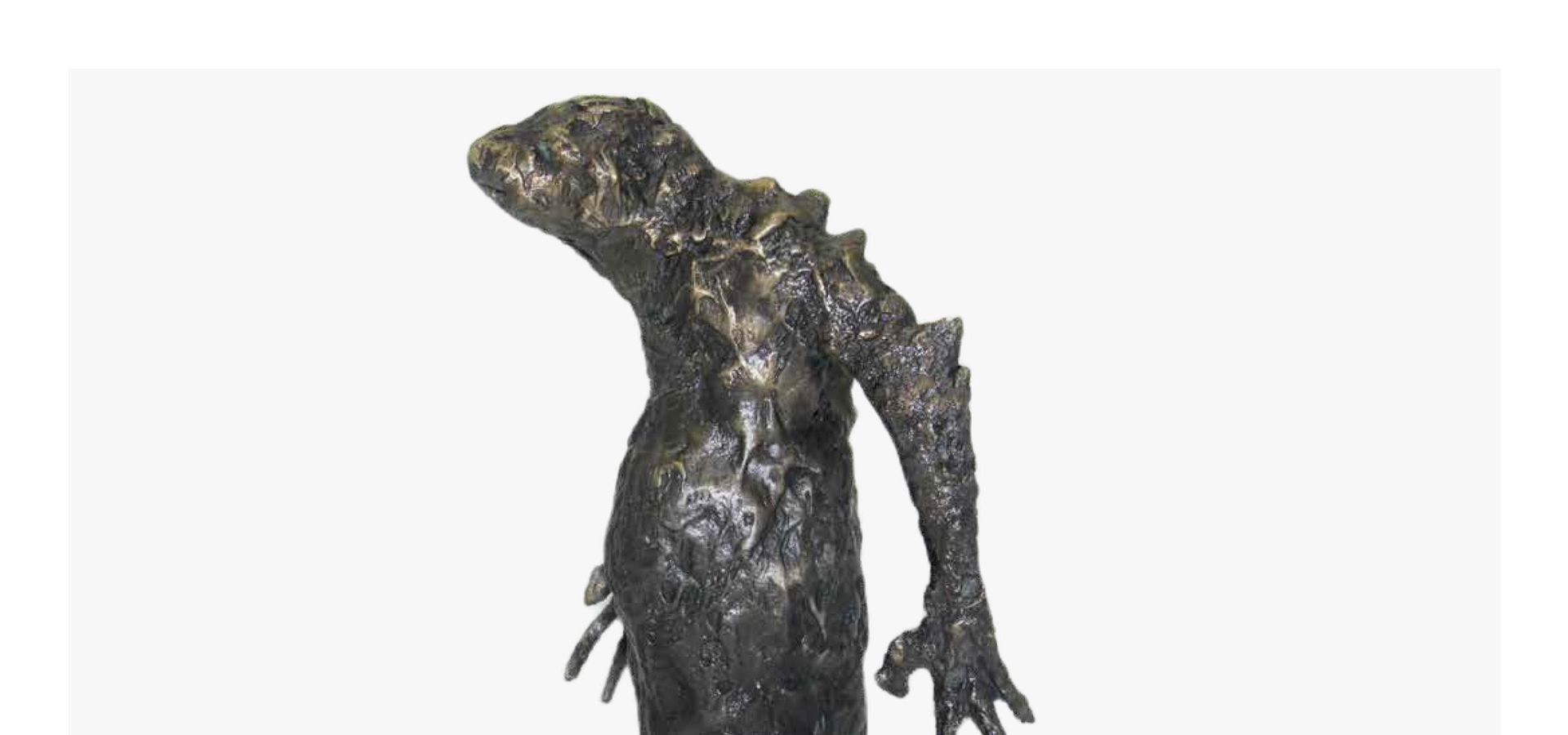
Scrying Pond
A grotesque creature is depicted laughing, seated atop a violin bereft of strings—an image both striking and mysterious. Set upon a mirrored base that tantalises and reflects, it adds depth and intrigue, inviting contemplation on multiple levels. The stringless violin, held gracefully by a disembodied hand, symbolises a bridge between the artistic and the ethereal, resonating with the cultural richness of music's universal language. Yet, in its silence, it questions the unspoken and the ineffable.
The disembodied hand adds a surreal quality to the scene, mediating between tangible and intangible realms. It suggests a detachment from corporeal reality, a connection between the absurd and the sublime, perhaps symbolising the elusive nature of true artistic expression. The absence of strings on the violin further complicates the metaphor, transforming the instrument from a tool of melody into an icon of silence, a void filled with potential and a statement about the limitations and possibilities of communication.
Below this captivating scene, the mirror acts as a scrying pond. It casts back the viewer's image, becoming a gateway to self-reflection, intertwining the viewer's reflection with the art, transforming it into an interactive experience that reaches the subconscious.
The creature's grotesque form, captured in a moment of wild laughter, initiates a discourse on the multifaceted nature of human emotion, a juxtaposition of the ecstatic and the eerie. The stringless violin, held by a hand disconnected from a body, amplifies the paradox, symbolising unspoken emotion, unplayed music, and unfulfilled potential.
The interplay between the bronze and the mirror creates a dynamic contrast, balancing the earthiness of the material with the ethereal quality of the reflection. The scrying pond's surface is murky, juxtaposing the complex textures of the bronze, symbolising the dual nature of existence where clarity and complexity coexist. "Scrying Pond" becomes a poetic dialogue of reflection and revelation, retelling the mystical exploration represented by the scrying mirror throughout history.
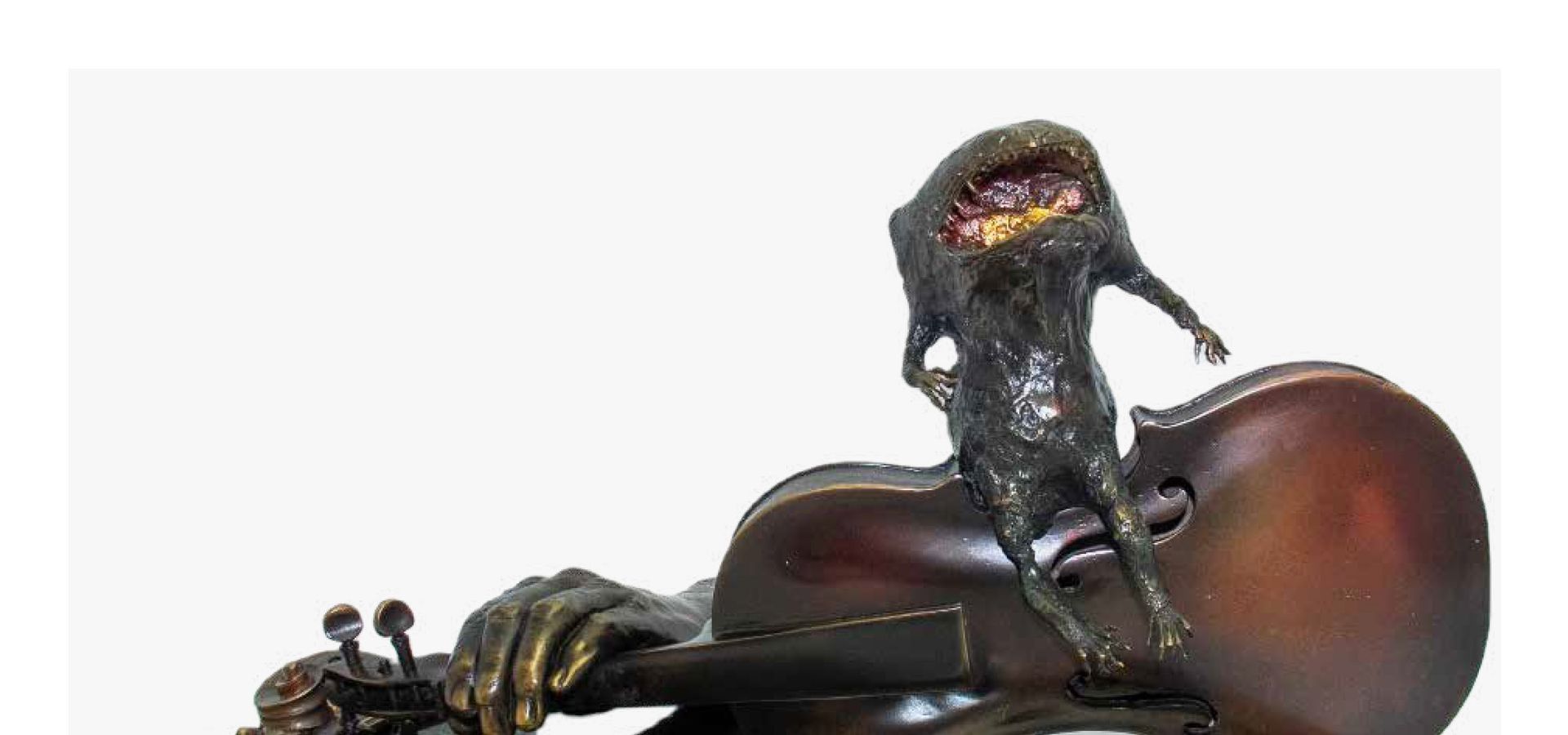
Perfect Harmony
In Lera Auerbach's "Perfect Harmony," a contemplation on the nature of concord and unity is artfully orchestrated. By transforming a violin and trumpet, traditionally crafted from wood and metal, Auerbach reimagines them in bronze, orchestrating their fusion into one seamless entity. This transcendent blend, a symbol of birth from the earth and deeply rooted in nature, offers an insightful perspective on existence's underlying synchrony.
Beyond mere aesthetics, the brass valves replacing the violin's strings and the trumpet's bell growing as if a tree from the ground resonate like orchestration constructions in a symphony. These elements rise as profound symbols, suffused with the essence of the earth, emphasizing a foundational consonance that echoes our intrinsic connection to nature.
The doubling of the violin's scroll to form a heart goes beyond sentimentality; it harmonizes the sculpture's philosophical core. This intricate detail represents the potential for disparate elements to unite in a composition that reaches beyond an artistic sphere, reflecting a universal theme of connection and unity.
Auerbach's "Perfect Harmony" conveys a complex unity, intricately composed like a piece of music. Though the instruments are merged, they maintain their individuality, reflecting the multifaceted nature of human connections and the elaborate tapestry of nature itself. This representation underscores the innate ability to find compatibility within diversity, weaving together brass and strings in a resonant harmony that mirrors life's vibrant complexity.
Through this captivating visual creation, Auerbach offers a work that speaks to the integration of elements, resonating with the observer's eye and deeper layers of understanding. "Perfect Harmony" is visually and philosophically compelling, a meditation on unity masterfully composed and orchestrated. Reflecting a profound fusion of synthesis, diversity, and the metaphysical, it invites contemplation on unity, resonating with subtle grace and beauty like a lingering melody that enchants long after its cadence.
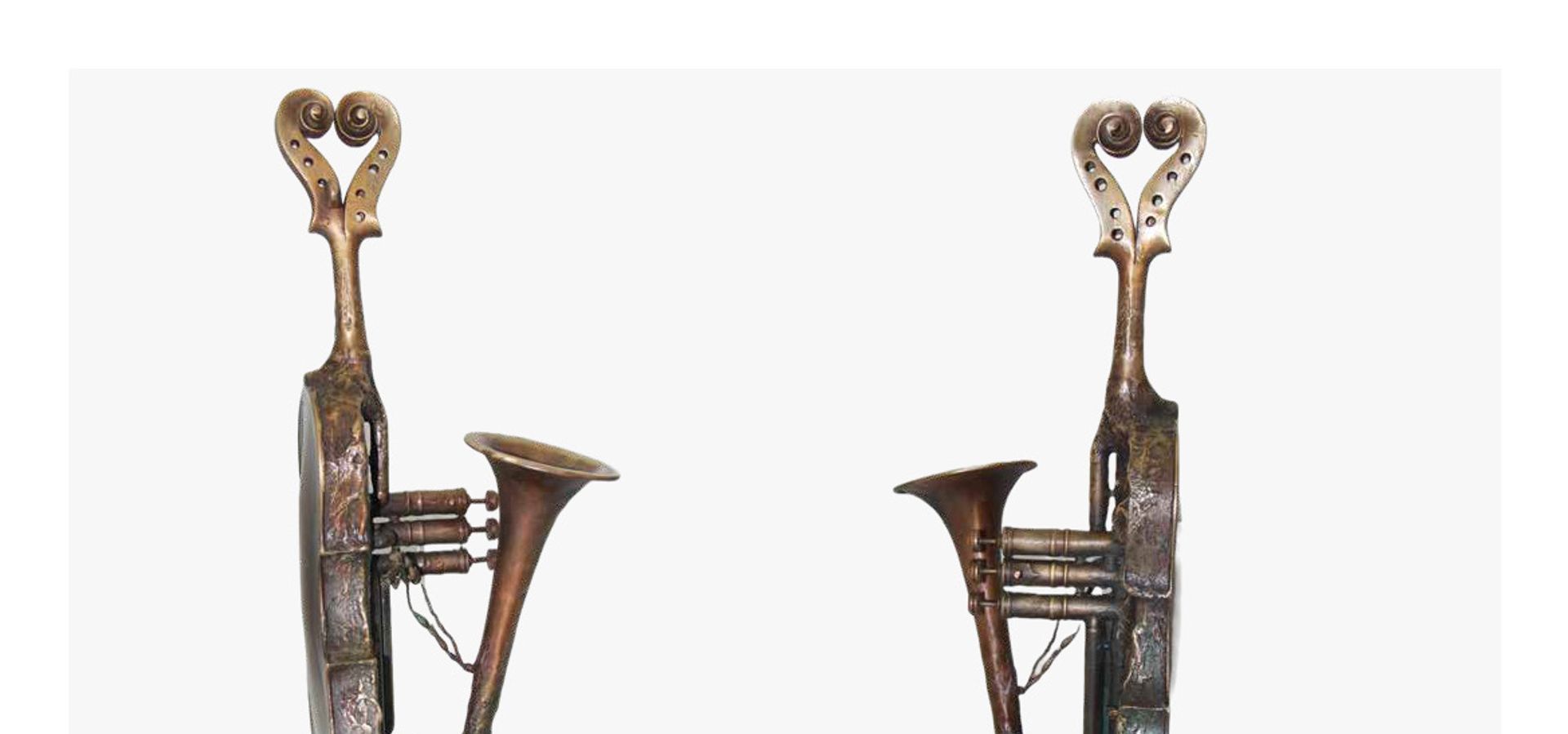
NYX
Teeming with archaic symbols and cryptic references, the aesthetic of Auerbach's sculpture NYX invites us into an intellectual and spiritual pilgrimage, one resonating with ancient wisdom and cosmic harmony. The sculpture's reference to Nyx, the Greek primordial goddess of the night, hints at existence's profound mystery. In Orphic cosmogonies — a set of ancient Greek religious beliefs — Nyx becomes an unapproachable and ineffable mother of destinies.
Observing the figure's contemplative pose, sitting on the skull of another creature, we are brought face to face with an eternal observer who transcends time, culture, and form. This figure, incorporating the bird's skull as the creature's head and beak, underscores a duality between life and death, linking directly to nature's cycles. This theme of duality is not merely aesthetic; it signals a recognition of mortality and the perpetual cycles governing our existence.
The sculpture's thematic complexity continues with the moon's presence, historically aligned with femininity, the subconscious, and life's ebb and flow. It alludes to the alchemical process of solvé et coagula, a phrase meaning dissolving and coagulating, emphasizing a transformative process within the observer's psyche between the known and unknown.
The observer's role in this sculpture creates an ouroboros-like cycle of observation and reflection. It transforms the chimeric figure into a transcendent archetype, embodying the Hermetic axiom, "As above, so below; as below, so above." This ancient principle suggests a universal symmetry between the macrocosm and microcosm.
Auerbach's integration of aural elements further enriches the interplay. NYX: Fractured Dreams, Auerbach's Violin Concerto No. 4, is symbolized by the sculpture's moon, engraved with the opening lines of the piece. This echoes ancient Pythagorean mystique, seamlessly interweaving auditory with visual elements.
Reflecting musica universalis, or the idea that celestial bodies move in harmony, the work synthesizes NYX's cosmic harmony with the tangible. Drawing on themes of the feminine, subconscious, and alchemical transformation, it crafts a cryptic poem in bronze.
Auerbach's sculpture weaves a rich tapestry, inviting us to an intellectual and spiritual journey. With a harmonious interplay of symbolism and aesthetics, NYX serves as a meeting point of past and present that echoes in the chambers of the mind, marking an intriguing convergence of art, myth, and contemplation.

Dreaming of Flying
The sculpture "Dreaming of Flying" unfurls a wingless, enigmatic creature delicately suspended in an ethereal limbo between slumber and demise, stagnation and transformation. This piece emanates a contemplative aura, saturated with themes of yearning, metamorphosis, and the intricate dance between the realm of Morpheus and the abyss of mortality. It serves as a cosmic gateway where dreamscapes infiltrate waking consciousness, and the stark finality of death mingles with the labyrinthine mysteries of an ever-permeable reality.
The form's elusive state is a heart-wrenching epitaph of vanished aspirations and the forsaken allure of airborne freedom. Yet, in the shadow of mythology, it also whispers of the Phoenix's cyclical immortality, thereby encoding a spiritual ascension. Death, then, becomes not an end but an initiation into an alternative form of flight—into the sublime.
Intersecting the realms of the waking world, the Freudian subconscious, and mythic lore, the wingless sculpture invokes complex narratives around our conscious lives, shadowy yearnings, and collective storytelling. The absence of wings—akin to Icarus' melted appendages—may signify the inexorable boundaries that confine our desires, offering a poignant psychological tableau of our confrontations with reality often resistant to the whims of fantasy.
The piece is a metaphysical liturgy on the omnipresent human quest for rising above, even when tethered to mortality's inexorable gravity. Poised between dualities, it encapsulates our aspirations for the heavens even as we remain enchained by earthly limitations. "Dreaming of Flying" crystallizes as a staggering ode to the enigmatic conundrum of our existence, igniting contemplation on our pursuit of evanescent dreams—either as a tribute to the unyielding resolve housed in our mortal vessels or as a ghostly murmur of our inherent boundaries.
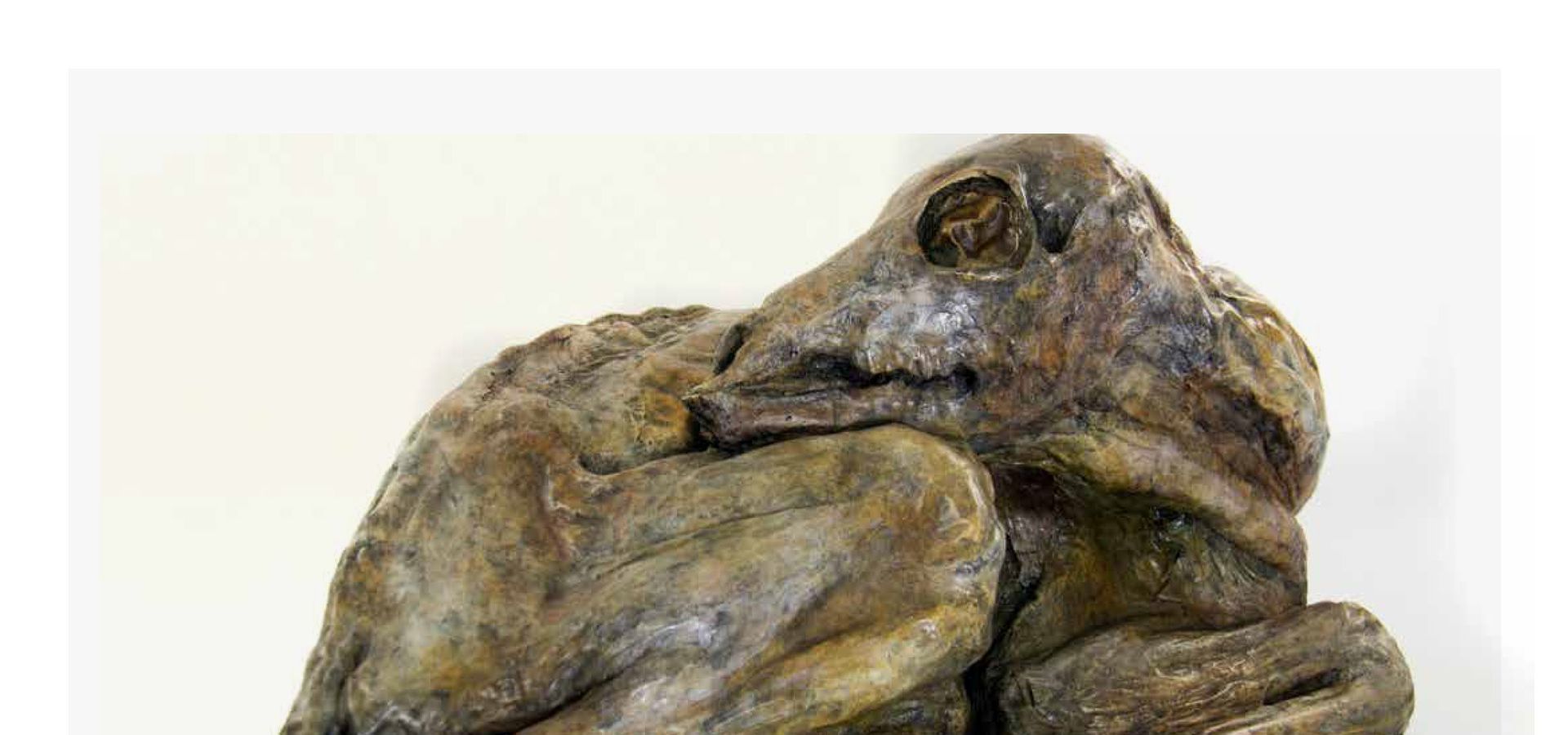
Hear me
In Auerbach's "Hear Me," one confronts a profoundly intense interrogation of existential desire and agony, captured through the embodiment of a quadruped creature ensnared in what appears to be a seemingly eternal scream. It inhabits a liminal space, balanced precariously between life and decay, vitality and oblivion. Its existence, trapped in a temporal void and suspended in a state of torment, exhibits an urgency that resists specific interpretation. This elusiveness thereby opens a labyrinthine inquiry into our communication modalities and raises profound questions about the nature of understanding, serving as a gateway into deeper reflections.
In its universality, the primal scream defies language and cultural specificity barriers. Yet, the core of its meaning remains concealed, shrouded in ambiguity, and bereft of context. Does the scream signal the onset of suffering, or does it resonate as a liberation cry? Is the being entrapped in an unbridgeable abyss of isolation, or is there a straining outreach, a yearning to connect with those who witness it? These questions lead us further into the sculpture's complex narrative.
The sculpture's fraying bronze texture, unravelling and yet resilient, layers the narrative with further intricacy. It simultaneously attests to the medium's enduring quality and its form's inherent ephemerality, thus setting forth a paradoxical contemplation on the notion of immortality vis-à-vis the frailty of existence. This textural exploration offers an acute reflection, tinged with a melancholic recognition that even the most resilient matter cannot elude the relentless march of time and decomposition.
As an allegorical memento casting its shadow upon the sensory cusp of mortality, "Hear Me" transmutes into a poignant, reflective commentary on the transient ephemerality that characterizes life itself. This culmination brings together the diverse threads of existential questioning, universal communication, and the paradox of permanence, weaving them into a compelling dialogue on what it means to exist, connect, and endure. In this refined synthesis, "Hear Me" stands as a profound intersection of art and philosophy, engaging the observer in a contemplative experience that transcends the ordinary.
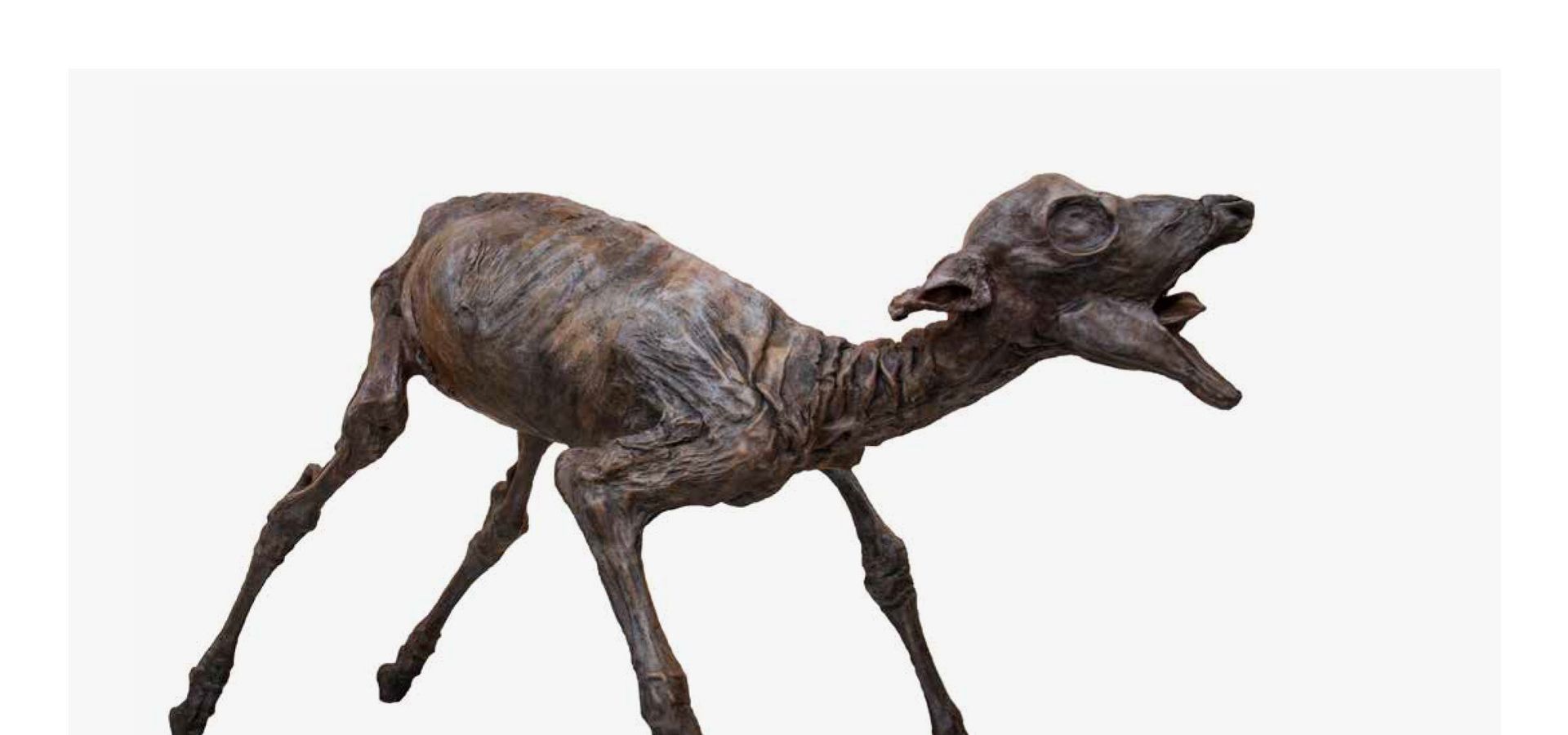
Violinist
A contorted figure emerges in Auerbach's "Violinist," a synthesis transcending a mere human and animal identity amalgamation. This chimeric being resonates with the creatures of classical antiquity and the grotesqueries hidden in the alcoves of Gothic cathedrals. With an upturned face as an aperture towards an unseen heaven, the beast appears to channel not a howl but an existential cry reminiscent of the Minotaur's primal and timeless anguish, trapped within a self-imposed labyrinth.
In the figure's left hand, a violin is clutched and thrust into the chest, a desperate act of self-expression. The broken and disconsolate strings intensify the despair and confusion, forging a visual metaphor for discord and shattered harmony. Here, the violence of the act, the fusion of human and beast, and the contorted posture converge to weave a dark tale about the fine line between creation and destruction, passion and madness.
Beyond the immediate narrative, the work addresses a more profound artistic struggle—the agonizing gap between the artist's vision and the constraints of reality. It articulates the frustration of an inability to reach ideal perfection, a perfection unattainable by definition, and this ceaseless pursuit resonates with the creature's torment.
The portrayal of the violin as an instrument of art and an emblem of conflict enhances the work's complexity. It becomes a symbol of the artist's voice, sometimes stifled by its intensity and the burden of expectation. Auerbach's creation crafts a visual exploration of the eternal struggle between perfection and imperfection, summoning the viewer into the inherent chaos lurking within art and creativity.
By intertwining the musical with the monstrous, Auerbach orchestrates a symphony of conflicting emotions, weaving a dark tale where passion and madness are fused, reflecting the artist's inner turmoil. The "Violinist" serves as a poignant reminder of the dual nature of art, where beauty and horror coalesce, and the quest for perfection can become both a driving force and a haunting obstacle. It stands as an evocative embodiment of the universal human experience, resonating with themes of aspiration, despair, and the often-tumultuous journey of self-expression.
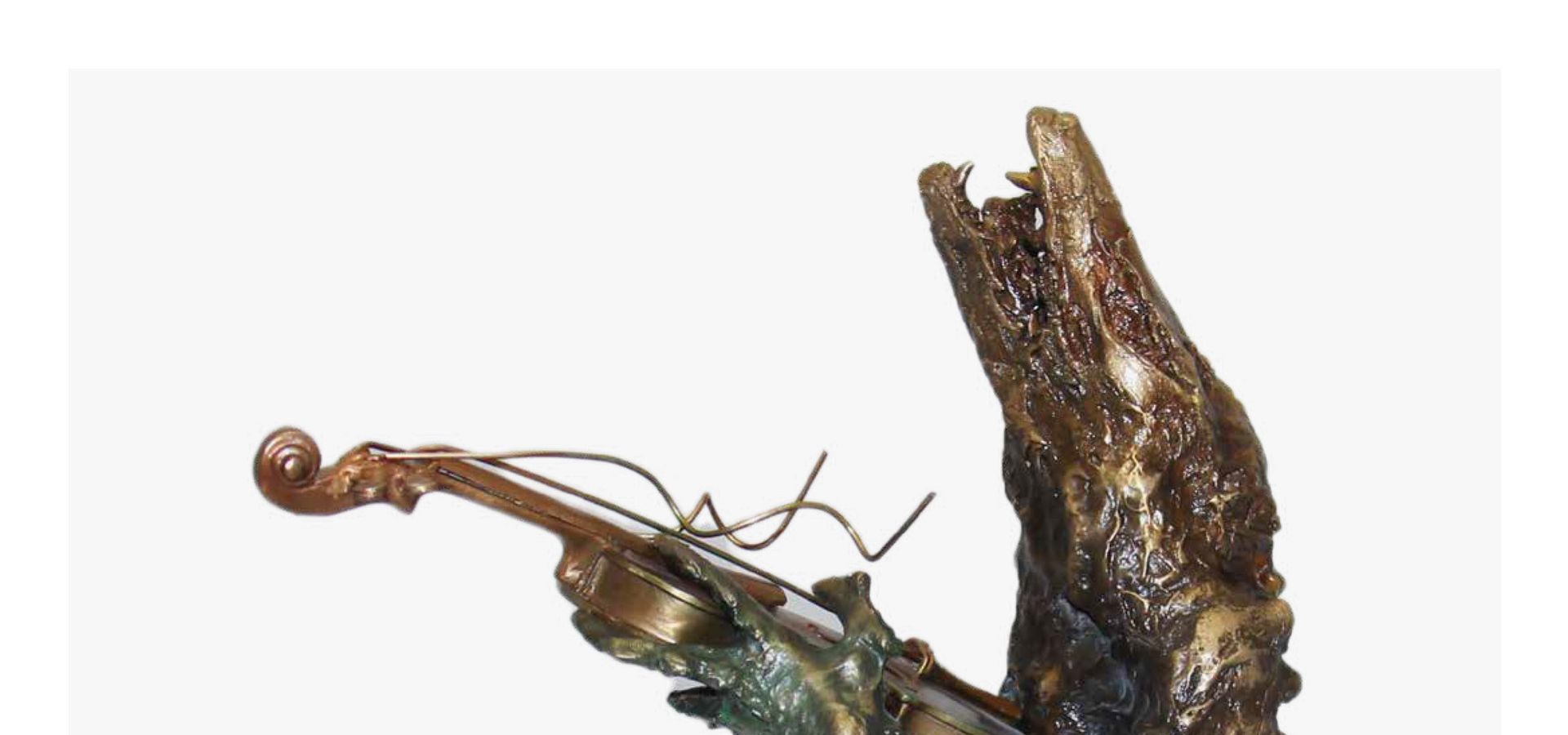
Vowed for Life
A deeply personal reflection, Auerbach bronze sculpture 'Vowed for Life' intertwines the seemingly disparate themes of DNA mutation and marriage. This intricate fusion forms a complex metaphor, unifying two profound connections that shape identity and destiny: the chosen bond of matrimony, symbolizing love and commitment and the melding of two in one, and the unchosen, tragic bond with radiation, symbolizing cellular mutation and genetic alterations.
Born in a region marked by the Kyshtym disaster, a radioactive accident which occurred on the 29th of September 1957 at Mayak, in the closed city of Chelyabinsk-40, Auerbach connection to radiation's effects informs her work. This personal history lends gravity to a striking juxtaposition, reflecting how these bonds, though different in nature, hold powerful sway over life.
The sculpture's mutated, two-headed form uniquely symbolizes these dualities. Its twisted, embracing figures, almost dancing in their eternal connection, are elegant and alarming. The chosen marital vow, a consensual union, is captured in two beings eternally united—a dance of love, harmony, and reflections. Yet within this exact form, the unchosen commitment to radiation's insidious lifelong effects on the body and psyche is also represented—an involuntary marriage to radiation, a bond offering no choice and lasting a lifetime.
In 'Vowed for Life,' Auerbach has woven two themes that resonate with the contradictions and complexities inherent in human bonds and commitments. Her sculpture asks us to look and compels us to confront the unseen bonds that can elevate and ensnare. It is a work that transcends context, reaching the essence of what it means to be bound by choice or fate.
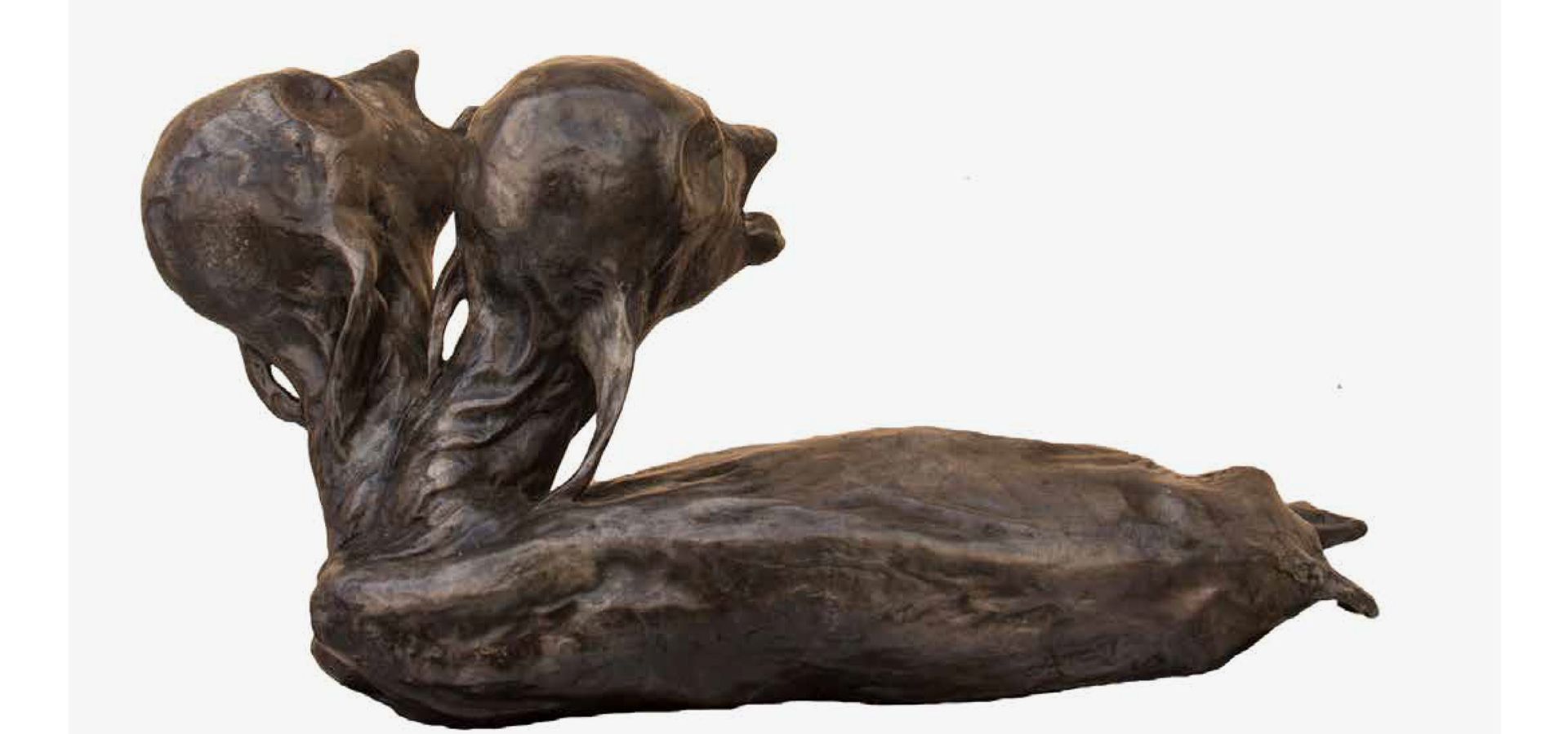
Raising
A bronze skeletal figure of a fragile creature balances atop a rock, poised in ascension. Stripped to its essence, this sculpture, "Rising," by Auerbach, reveals deep layers of symbolism, oscillating between frailty and strength.
The skeletal form serves as a metaphor for our human condition, devoid of worldly facades, prompting questions about identity and aspiration. "Rising" is more than a mere visual display—it's a meditation on the fundamentals of life. It explores the tension between striving and caution while capturing our collective ambition and fragility. The work urges us to reflect on the forces that propel our unceasing quest for upward reach.
Simultaneously, "Rising" exudes an ethereal quality, hinting at not just physical ascent but also spiritual enlightenment. Rather than being solely a testament to human strength, the sculpture invites us toward higher consciousness, transcending the material to touch the ineffable. "Rising" serves both as a challenge and an inspiration, mirroring our personal journeys and the very essence that drives us.
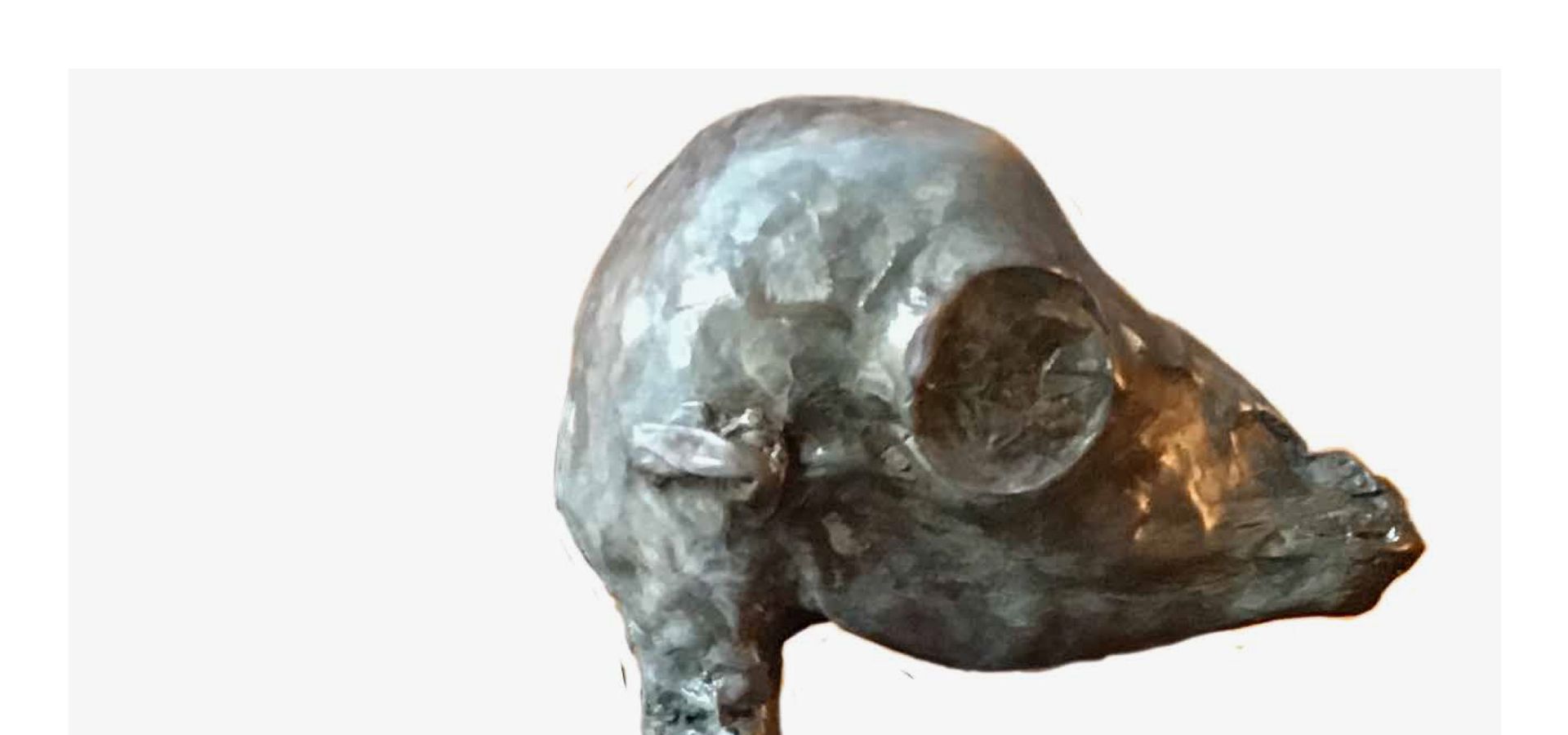
Silent Psalm
Fluidly traversing meaning from one artistic medium to another, Lera Auerbach's Symphony No. 6, Vessels of Light, and her sculpture Silent Psalm, are intricately interwoven, merging the Judaic concept of Tikkun Olam (the repairing of the world) with Kintsugi, the Japanese technique also known as Kintsukuroi, (Golden Repair) that illuminates the scars of breakage instead of masking them, thus enhancing the beauty and uniqueness of the object. Like the symphony's interwoven melodic threads of the cello line that repair the broken stanzas of the Yiddish poems vocalized in the symphony, the sculpture represents the historic arch that binds the suffering and survival of the Jewish people scattered across the world yet remains mysteriously, multiculturally united.
Psalm 121 of David, the Song of Ascents, "I lift my eyes to the mountains – where does my help come from?" provides a vital element of the symphony's construct, remaining silent as a metaphor for the unspeakable, fragmented, and in shards. "After completing the Psalm, I shattered it; its fragmented musical material – without words – appears in the interludes, with the solo cello in a binding embrace that holds the different parts together, making them more robust and creating a sense of unity," explains Auerbach.
The inspiration behind these works comes from a commission by Yad Vashem – The World Holocaust Remembrance Center to commemorate the actions of Japanese diplomat Chiune Sugihara (1900-1986), who defied orders as the vice-consul of Japan in Kaunas, Lithuania, during World War II by issuing transit visas through Japanese territory to persecuted Jews fleeing Europe, saving thousands of lives. Yet, beyond this immediate context, Auerbach transcends the commemorative momentum through the transformative power of art, revealing the human condition as a moral quest for beauty and repair, the essence of humanity, even amidst destruction and violence.
The sculpture is a crafted bronze sheet of music, anchored by its stand, with Auerbach's original music score for the 121st Psalm and its text engraved in Hebrew. Broken into shards and repaired with Kintsugi, it exposes its cracks – a patinaed golden thread in the shape of a Magen David (Star of David) appears.
Auerbach unveils Silent Psalm at the Rudolfinum for the first time on March 21, 2023, in synchrony with the Prague premiere of Vessels of Light and Yad Vashem's Righteous Among the Nations exhibit. The sculpture is an integral part of the artistic concept that inspired both interrelated works, showcasing the artist's exceptional talent to seamlessly shift meaning and medium between music, art, and poetry.
